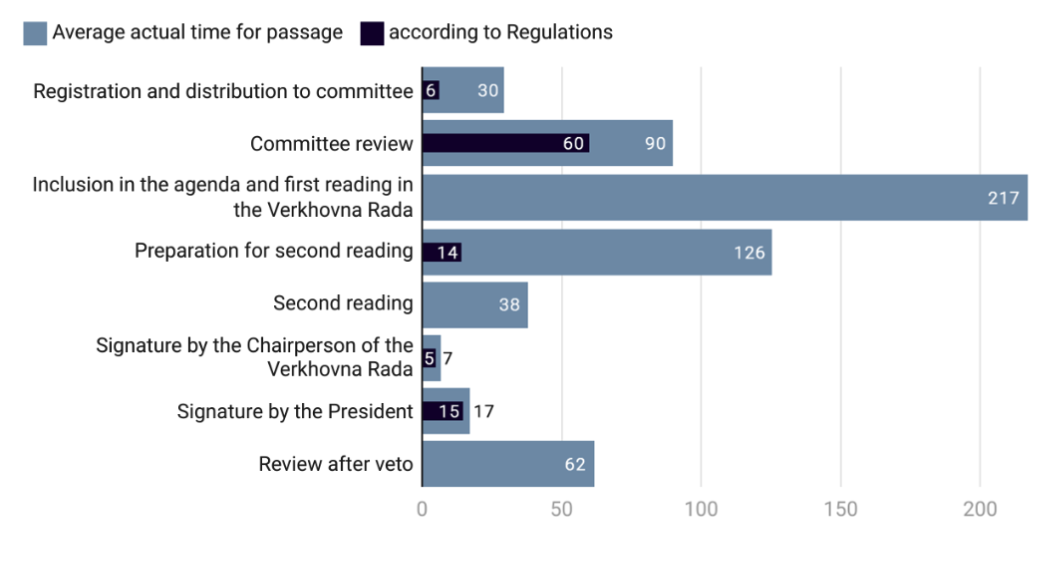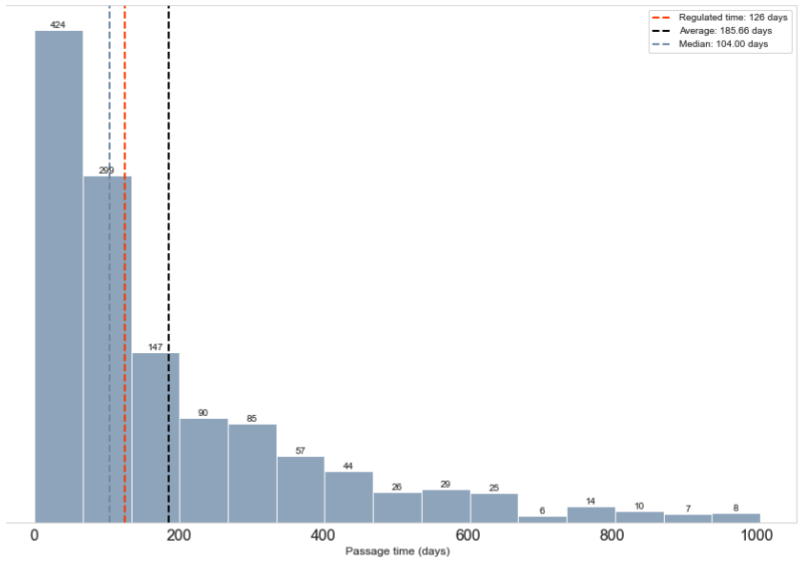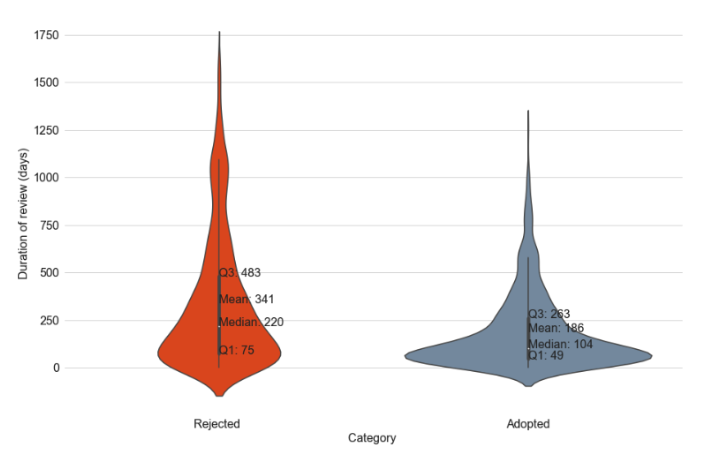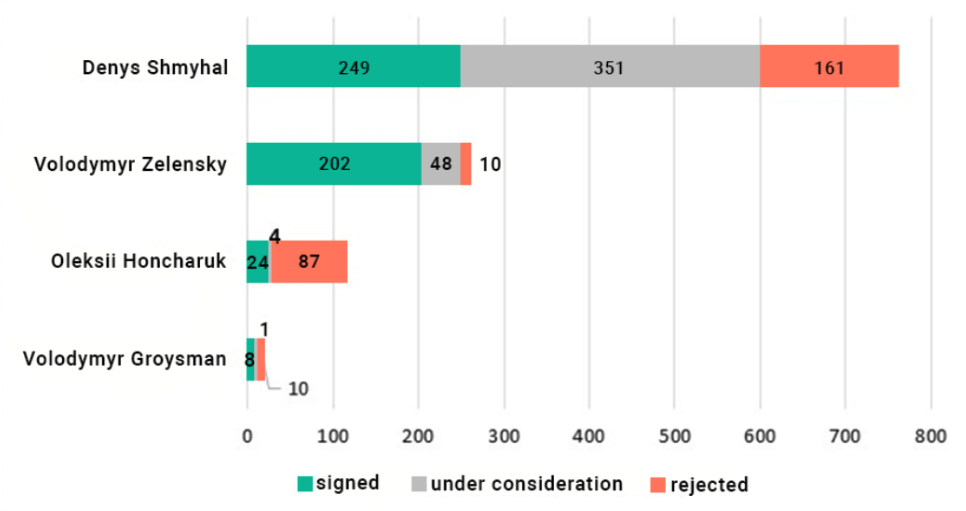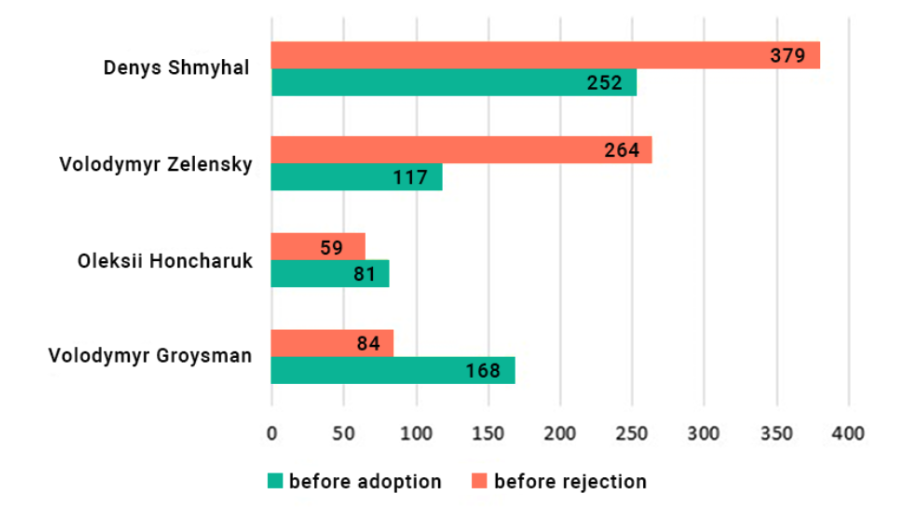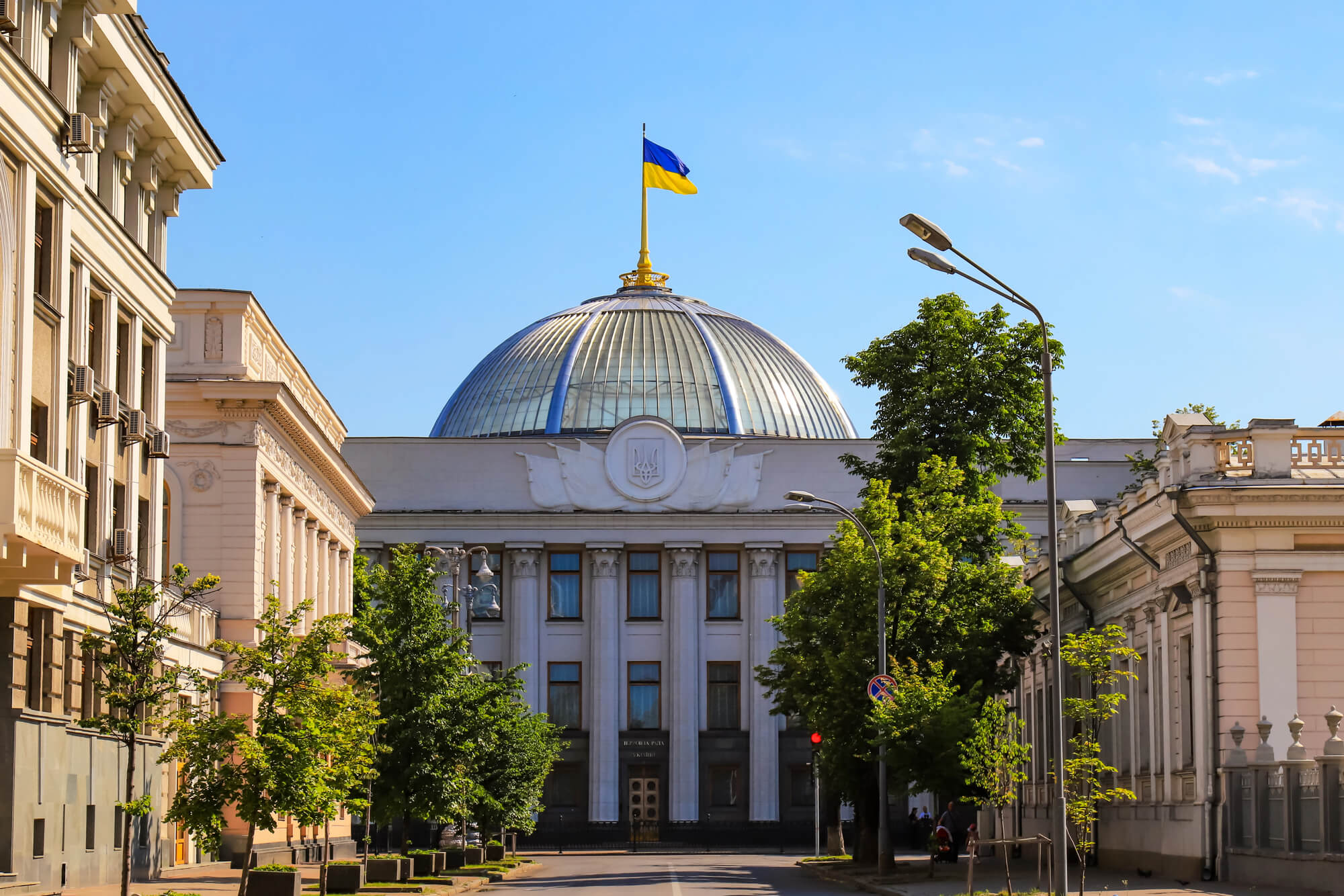How many bills has the Verkhovna Rada of the IX convocation managed to consider and adopt? At which stages do bills most frequently “get stuck”? What is the average time for a bill to pass through Parliament, and which bills pass through it more quickly? Based on data from Parliament’s website, we can answer these and other questions about the work of the current Verkhovna Rada and compare it with the work of the previous convocation.
- Key findings
- The stages of adopting a bill
- The intensity of bill registration
- Duration of bill adoption and rejection
- Bills under consideration
- Committee efficiency
- “Fastest” and “slowest” bills
- Bills on which topics pass through Parliament more quickly?
- How do the initiators most quickly and effectively “push” bills through Parliament?
- Summary
Key findings
- Parliament of the IX convocation has adopted almost ⅕ of the bills introduced to it. This is more than the previous Parliament but significantly less than, say, in Poland and Britain. Therefore, it is worth filtering out the “bill spam” before registration—specifically by accurately calculating the cost of implementing the bill for the budget. This would also relieve the committees struggling to cope with the flow of dubious initiatives and amendments, allowing them to process important bills more quickly and efficiently.
- Rejection of bills, on average, takes twice as long (a year) as adoption (six months). Although half of legislative initiatives are adopted even slightly faster than the theoretical time prescribed by the Regulations, the average time for their adoption is approximately two months longer than the normative time, as some bills wait for consideration for years. Therefore, if regulatory deadlines are frequently violated in many cases, perhaps they should be reviewed?
- The longest waiting time for bills occurs during parliamentary consideration after they are included in the agenda but before their first reading. There is no time limit for this stage in the Regulations, so it is worth introducing one.
- The highest proportion of adopted bills out of all submitted ones is with the President (78%). His bills are also considered quite quickly, approximately twice as fast as bills from the current Government (but slower than bills from the previous Government, which were considered in a “turbo mode”).
- MPs typically submit bills in groups. Among deputies who have individually submitted many bills, D. Hetmantsev stands out, with 38% of his initiatives adopted.
- Representatives of the former Opposition Platform – For Life (OPFL) faction submit relatively few bills to Parliament. However, their bills are usually rejected even when submitted as part of groups.
The stages of adopting a bill
To become a law in Ukraine, a bill goes through a lengthy process. The four main stages of this process are registration, consideration in the relevant committee, review in Parliament (and signing by the Chairman of the Verkhovna Rada in case of adoption), and finally, signing by the President of Ukraine. Some of these stages are clearly regulated in terms of time, while others are not, making it quite challenging to predict the speed of a bill’s adoption.
According to the Verkhovna Rada Regulations, the registration of a bill is completed within up to 5 days, and consideration in the Main Committee takes up to 30 days. At this stage, the bill may be returned for further revision or prepared for its first reading, which can take an additional maximum of 30 days. The next stage—inclusion in the agenda—can also take up to a month. From there, it should take up to 30 days until the first reading in Parliament.
Figure 1. Duration of bill consideration according to the Regulations, days
Source: Compiled by the author according to the Regulations of the Verkhovna Rada.
Note: Stages with undetermined durations are provisionally marked as "20?" (approximately 20 days) for presentation simplicity.
According to the regulations, a bill can undergo up to three readings:
- The first reading involves discussing the bill's basic principles, provisions, and structure. The outcome of the first reading may be the adoption of the bill in principle. If the relevant committee recommends adopting the bill as a whole, final adoption at this stage is possible. However, this happens quite rarely.
- The second reading involves a clause-by-clause discussion of the bill. MPs may submit amendments to the bill between the first and second readings. These amendments are systematized and recommended for adoption or rejection by the relevant committee. However, if the author of the amendments disagrees with its conclusion, the amendments are voted on in the session hall. Typically, at this stage, the bill is adopted in its second reading and as a whole (or not adopted).
- The third reading involves adopting the bill as a whole (only minor technical corrections are possible between the second and third readings). In practice, during the last three convocations, this procedure was only carried out once in 2015, resulting in a bill being vetoed by P. Poroshenko and subsequently repealed. Therefore, today, this stage only functions on paper. Currently, bills are adopted as a whole after the second reading or after a repeated second reading, which has taken on the functions of the third reading.
According to the regulations, there should be no more than 14 days between the first and second readings and five days between the second and third readings (however, in practice, these deadlines are often not adhered to—see Figure 2). The regulations also allow the Verkhovna Rada to decide (no more than twice) to hold repeated first and second readings of bills.
The Verkhovna Rada may adopt a bill as a whole (except for draft codes and bills containing more than 100 articles) immediately after the first or second reading if MPs agree that the bill does not require further refinement. If they have objections to the bill, they can send it back for revision to the relevant committee during each reading.
When people's deputies adopt a bill as a whole, the final stage of its adoption begins, which has clearly regulated deadlines:
- Five days are allotted for the bill to be signed by the Parliament Speaker and for the necessary documents to be transmitted for the President's signature.
- Within 15 days, the President must make one of two decisions: to sign the bill into law or return it to Parliament for reconsideration with their proposals (veto). In the absence of the President's decision, the bill is deemed approved and must be signed. However, in practice, this often does not occur, leaving the bill in an indefinite state for a prolonged period.
- MPs can accept the President's proposals with a standard majority of 226 votes (then we return to point 1), or they can vote to override the veto—this requires at least two-thirds of the people's deputies from the constitutional composition of the Verkhovna Rada (300 votes). The President is obliged to sign such a bill within ten days.
So, ideally, the path of a bill adopted in the first reading takes 126 days from the moment of registration, 140 days for one adopted in the second reading, and 145 days for one adopted in the third reading. These calculations are valid only under the condition that voting in Parliament takes place immediately after the decision to include the bill in the agenda. However, in reality, the timeframes for consideration are not strictly regulated; instead, they are determined by the Conciliation Council. A prepared bill can await consideration in the Verkhovna Rada for months. Delays are also possible at other stages (see Figure 2). How long are they?
To answer this question, we'll take data on bills for which Parliament has made a positive or negative decision. For some stages, their average time is approximate because the statuses of the bill reflected in its card may relate to both readings simultaneously (e.g., the status "Returned for revision" may mean the bill is returned to the committee for either a repeated first or second reading). For convenience, we have assigned such statuses to the stages where they are most commonly encountered. Additionally, in Figure 2, the first and repeated first readings are grouped together, as well as the second and repeated second readings.
Figure 2. The average duration of bill consideration stages - according to Regulations and actual time
Source: Compiled by the author according to the Regulations of the Verkhovna Rada of Ukraine and data from the parliamentary website. Note: Some stages do not have timeframes in the Regulations, so only the actual time is shown.
For details on the "pitfalls" along the path of a bill, refer to our last year's study, "From Bill to Law: the Process Needs Improvement."
The intensity of bill registration
To analyze the work of the ІХ convocation of the Verkhovna Rada of Ukraine, we took data from August 29, 2019, through February 18, 2024. During this period, a total of 11,142 legislative acts were registered, including 6,800 bills (61%) and 4,295 resolutions (38.5%). Further, we will only consider bills.
For comparison, during the entire term of the VIII convocation of the Verkhovna Rada (October 26, 2014 – August 29, 2019), 7,704 bills and 5,924 resolutions were registered – a record number since the existence of independent Ukraine. Parliament's current convocation has been in operation for 4.5 years already. If the pace of bill submissions remains the same, it should be able to process 7,500 bills in 5 years. Of course, the main concern is not the quantity of bills but their quality, however we will further consider some quantitative indicators.
Let's compare the number of bill registrations in the current and previous convocations, grouping the data quarterly. We will consider a comparable period of work for the VIII convocation, spanning 4.5 years (from the beginning of its work until May 27, 2019), during which 7,500 bills were registered.
Figure 3. The number of registered bills over 4.5 years of work for the VIII and IX convocations of the Verkhovna Rada, broken down quarterly from the beginning of each convocation
Source: Compiled by the author using data from the Verkhovna Rada website.
From Figure 3, it is evident that over time, the legislative activity of both convocations declined. In the first quarter, bill registrations were unusually high due to the re-registration of bills from previous convocations, which typically occurs at the beginning of the new Verkhovna Rada's term. During the first three months of operation, the ІХ and VIIІ convocations registered 713 and 882 initiatives, respectively. Notably, the VIII convocation maintained high legislative activity for over nine months, with over 2,300 bills registered during the first two sessions, averaging over 140 per month. In contrast, the IX convocation registered 1,662 projects during the equivalent period, averaging 125 per month, and experienced a slowdown immediately after the first two months of operation. The number of registrations sharply decreased during the first half-year of operation for both convocations and continued to decline steadily thereafter.
However, in the winter and spring of 2022, as well as in August-September 2023, the number of legislative initiatives submitted significantly increased. During these periods, deputies registered many bills related to martial law. In the summer of 2023, the process of European integration intensified, marked by the introduction of reform-oriented projects. Examples include Bill No. 9610, focusing on the implementation of rights and freedoms of national minorities, and Bill No. 9024-d, which addresses minimum oil reserves to enhance Ukraine's energy security. In November of the same year, President of the European Commission Ursula von der Leyen stated that Ukraine had fulfilled over 90% of its obligations for opening negotiations on EU accession. On December 14, 2023, negotiations began.
Among all registered bills in the IX convocation, 1,271 laws were passed and signed, constituting less than one-fifth (18.7%) of the total. However, this percentage is higher compared to the previous convocation (see Figure 4). The number of rejected bills is nearly twice as high (2,421), yet the majority of bills remained "in limbo" without a final decision. Nonetheless, their share is lower than in the previous convocation.
Distribution of bills considered by the IX convocation of the Verkhovna Rada as of February 18, 2024, and the III-VIII convocations as of the last day of work, by status
Source: Compiled by the author using data from the Verkhovna Rada website.
Therefore, the work of the current composition of the Verkhovna Rada can be considered successful for Ukraine. However, for example, the Parliament of Poland adopted 63.2% of the submitted bills (a total of 519) from 2021 to 2023, while the United Kingdom adopted 77.2% (118). Consequently, it can be assumed that bills in other countries are of higher quality (in other words, there is less "legislative spam" there).
Duration of bill adoption and rejection
The average time for a bill to successfully pass from registration to "Law signed" status is 186 days (see Figure 5). However, the median is 107 days, which is less than the hypothetical scenario of a bill being adopted in its first reading (the average time is increased by bills that are ultimately rejected; 23% of bills took longer than nine months to become law). Hence, we can infer that the majority of bills are adopted relatively swiftly, with 55% being approved in less than 126 days, which corresponds to the theoretical timeframe required for a bill to pass through two readings, as calculated above.
Figure 5. Distribution of time elapsed before the signing of the bill, days
Source: Compiled by the author using data from the Verkhovna Rada website. Note: The time of bill consideration is on the horizontal axis, while the number of bills is on the vertical axis.
The rejection of a bill takes significantly longer than its adoption (see Figure 6), clearly because bills can linger in an undecided state for a long time.
Figure 6. Duration of bill adoption or rejection
Source: Compiled by the author using data from the Verkhovna Rada website. Note: The first quartile (Q1) indicates the number of days it takes to reject/adopt 25% of bills, the median represents 50%, and the third quartile (Q3) denotes 75% of bills.
In the group of rejected bills, the median is 220 days, which is significantly higher than in the group of adopted bills (107 days). At the same time, 75% of rejected bills are rejected within 483 days, whereas three-quarters of adopted bills completed their journey to a final decision almost twice as quickly, within 263 days.
Let's compare these indicators for the ІХ convocation Parliament before and after the full-scale invasion. Before February 24, 2022, the median time for a bill to be rejected was 176 days compared to 220 now, while the time for adoption was 127 days compared to 104 now. Therefore, the duration of bill adoption has significantly decreased, while rejection now takes 25% longer.
Bills under consideration
Let's delve deeper into which stages bills most commonly stall and compare this with statistics from the previous convocation.
Figure 7. Distribution of bills in progress as of February 18, 2024, by status
Source: Compiled by the author using data from the Verkhovna Rada website. Note: For the VIII convocation Parliament, the entire period of its work was considered — from October 26, 2014, to August 27, 2019.
Grouping all stages of bill processing in the committee, we see that three-quarters (75.4%) of all projects are located there (see Figure 7). This is not surprising, as due to the heavy workload, committees often do not manage to process bills in a timely manner. There are a total of 23 committees, each consisting of 4 to 36 members; on average, there are 17 members in one committee.
Let's model the "ideal" work of a committee. Since the start of the convocation, 1,140 working days have passed, and a total of 6,800 bills have been registered. Assuming that bills are evenly distributed among the committees, each committee should fully process a bill in no more than 3.8 working days (in reality, committees have less time for this because, in addition to reviewing bills, they also perform other tasks, such as monitoring the implementation of the State Budget or interacting with specialized oversight bodies). During this time, the committee must be able to preliminarily review the bill and prepare key recommendations, which will be presented during the hearings in the session hall. After the hearing, if necessary, the committee must refine the bill, summarize the comments, and make amendments. Sometimes, the number of amendments can be measured in thousands.
For example, the long-suffering Electoral Code, which deputies of the VIII convocation had worked on for several years, received 4,568 amendments, none of which found support in the session hall. In the end, three plenary weeks were devoted to its consideration. The ІХ convocation Parliament set new records by submitting 10,902 amendments to the "anti-Akhmetov" government bill No. 5600, which increases the tax burden on producers of iron ore products and the agricultural sector (establishing a minimum land fee and excises; taxes poultry farmers), and over 16,000 amendments to the so-called "anti-Kolomoisky" bill (preventing the return of PrivatBank to its previous owners).
The phenomenon has been termed "amendment spam." It is a mechanism to block or delay the consideration of important legislative initiatives. To curb "amendment spam," a separate law was even passed, establishing a special procedure for considering bills that have received excessive amendments. According to this law, factions can insist on five amendments, while individual deputies can only propose one, speeding up the bill's consideration. However, essential bills still receive a large number of amendments, such as the mobilization bill (highly anticipated by society), which received 4,195 amendments before the second reading.
It is evident that committees are unable to fulfill all their duties promptly and with the desired level of quality. Therefore, it is advisable to alleviate the overall workload on committees and Parliament by implementing stricter selection criteria for bills at the registration stage. This approach would help reduce the influx of low-quality initiatives.
Nearly all projects that are not with the committees await consideration in the Verkhovna Rada (588 initiatives, or 21.8% of all those in progress). It is worth noting that the duration of waiting for a project to be put to a vote is not regulated, and consideration can be postponed an unlimited number of times. It is at this stage that a bill can easily be "lost" or "held up."
The status "Proposals considered" is mainly assigned to bills after the committee has completed its work on the proposals submitted to the bill after the first reading. Subsequently, the bill must undergo another vote during repeated first reding in the session hall. As of February 18, 2024, 35 bills with this status are "pending."
Thirty-seven bills are awaiting the President of Ukraine's signature, one of which has been pending since 2019. The Constitution allows 15 days for the President to sign or veto a bill. According to the Regulations, if this does not happen within the specified time, the bill is automatically considered approved and must be published and enforced. In practice, however, a bill can "hang" for years. Interestingly, two such bills were initiated by President Volodymyr Zelensky himself: a bill allowing the armed forces of other states to enter Ukraine for training has been awaiting signature since December 2021 and has already lost its relevance, while a draft law ratifying a financial agreement with the European Investment Bank has been awaiting signature since February 22, 2022.
For bills that were under consideration as of February 18, 2024, the average waiting time for the President's signature is 526 days, with a median of 439 days. Moreover, as of this date, 32 out of 37 bills have exceeded the 15-day regulated waiting period (see Figure 8).
Figure 8. The average duration of bills under consideration as of February 18, 2024, at the current stage of processing
Source: Compiled by the author using data from the Verkhovna Rada website. Note: For each bill, the time taken from its arrival at the current stage (the last among those passed) until February 18, 2024, was considered.
More than half of the unprocessed bills (1,777 out of 3,108) were initiated before the start of the full-scale invasion, and only 107 of them (6%) had a change in their passage status during the period of the major war. Most of them are no longer relevant, and their consideration may not be timely, but they increase the average processing time for each stage. However, if we consider only the bills registered during the invasion, the actual processing time will decrease, but the ratio of time spent at each stage will remain similar. Projects initiated after February 24, 2024, remain the longest at the stages "Returned for revision" and "Being processed in committee" – 369 and 306 days, respectively. The average waiting time for the President's signature exceeds the regulated time by 15 times and amounts to 224 days.
Committee efficiency
After registration, a bill immediately goes to committee consideration, where the main work is conducted. At this stage, the bill passage speed depends on the committee's "industriousness" and workload.
In addition to analyzing and refining the submitted initiatives, committees are tasked with ensuring their quality and societal benefit and rejecting unnecessary ones. To assess the committees' efficiency, let's examine the share of processed bills (approved or declined) among all submitted (Figure 9) and the average processing time of bills (Figure 10). This share is an indicator of how well the committees fulfill their direct responsibilities. Figures 9 and 10 show that the most effective committee is the one on European integration. Of course, it had significantly fewer bills than, say, the committees on law enforcement or finance. However, the committees on youth and sports affairs and digital transformation, which had even fewer bills, took nearly three times longer on average to consider draft laws. The Committee on Freedom of Speech could be viewed as an "outsider" since it had only three bills during the period reviewed, of which it considered two, each taking an average of 106 days.
Figure 9. Number of bills reviewed and processed by committees
Source: Compiled by the author using data from the Verkhovna Rada website.
Figure 10. Number of bills, the proportion processed, and the average time of consideration per bill by committees
Source: Compiled by the author using data from the Verkhovna Rada website. Note: The circle size represents the proportion of bills processed by a specific committee. The horizontal axis represents the total number of bills, and the vertical axis represents the average consideration time per bill. Committee names are abbreviated for convenience.
The lowest share of processed bills is in the Committee on Social Policy. This committee ranks third in terms of the number of projects it considers. According to the committee's chairperson, Halyna Tretiakova, the majority of the initiatives submitted entail significant additional expenses from the state budget without corresponding compensatory measures. The committee calculated that to implement the provisions of all bills that came to it in 2019-2020, it would require the country's four annual state budgets.
It is understandable that every deputy wants to boast a "social" bill in their portfolio. Although many of them do not become laws due to lack of funding, this creates a burden on the committee. Therefore, it is worth considering ensuring that realistic, rather than formal, calculations of these expenses are added to such bills, as well as other projects that require additional budgetary expenditures. These calculations could be carried out, e.g., by the parliamentary budget office, if (and when) it is established.
"Fastest" and "slowest" bills
As expected, the fastest adoption is seen in the resolution introducing a state of emergency and martial law, as well as amendments to the budget with the onset of a full-scale invasion. Ratifying the Istanbul Convention on preventing violence against women took only four days (though it was postponed for more than ten years for contrived reasons).
On the other hand, the Verkhovna Rada took the longest time to adopt the law on protecting Ukrainian labor migrants from fraudulent intermediaries, namely 1,259 days. This bill was included on the agenda in December 2019 and passed the first reading in June 2020. The bill was supposed to be prepared by the Committee for the second reading within 14 days, but this did not occur until May 2022. At the hearing in July 2022, it was sent for a repeat second reading, which took almost a year (until March 2023). Thus, overall, this bill spent over 2.5 years in committee processing and awaited consideration in the hall for nearly nine months.
Table 1. Top 10 fastest and slowest adopted bills
Source: Compiled by the author using data from the Verkhovna Rada website.
A similar situation occurred with another "record-holder," the law on increasing fines for illegal fuel trading, signed 1,061 days after its introduction to Parliament. It spent a year under revision between the first and second readings and, in total, awaited consideration in the hall for nine months.
In third place is the bill aimed at enhancing criminal liability for official negligence, which remained pending for over two years, awaiting its second reading. This bill proposes to amend Article 367 of the Criminal Code by adding a third part, which establishes punishment for official negligence resulting in death, specifically imprisonment ranging from 5 to 8 years.
The bills in the fourth and fifth positions "hung" in committees for two years, one between the first and second readings, and the other awaited the committee's conclusion for consideration before the first reading.
Bills on which topics pass through Parliament more quickly?
All legislative proposals at the registration stage are categorized into eight directions: security and defense, sectoral development, humanitarian, economic, social, and legal policies, state building, and international treaties. The Main Department for Documentary Support of the Verkhovna Rada of Ukraine determines the category of the legislative proposal based on its content and enters it into the database. The distribution of adopted bills by categories is presented in Figure 11. Most proposals pertained to economic policy and sectoral development (26% and 23% of adopted bills, respectively).
Figure 11. Distribution of adopted bills by categories (IX convocation Parliament)
Source: Compiled by the author using data from the Verkhovna Rada website.
Figure 12. Average time and median of bill signing by categories (days)
Source: Compiled by the author using data from the Verkhovna Rada website. Note: The size of the circle represents the number of bills.
Figure 12 shows the average and median time for the passage of legislative proposals belonging to different categories. Naturally, laws related to security and defense were adopted the fastest, with the average time and the median time from the bill's submission to the President's signature being 110 and 56 days, respectively.
Legislative proposals related to sectoral development and social policy took the longest to adopt (on average, 248 and 247 days, respectively). However, social policy changes are adopted the slowest, with the median time in this category being 226 days compared to 185 for sectoral development.
For bills in the legal policy category, the average time for passage is nearly twice as long as the median. The explanation is simple: this category includes several legislative proposals that hold the record for the slowest passage through Parliament. These notably include legislative proposals concerning the protection of labor migrants from fraud and the criminalization of smuggling (see Table 1)
How do the initiators most quickly and effectively "push" bills through Parliament?
Let's examine the speed of passage of bills, as well as the proportion of adopted legislative proposals by initiators. The total number of initiators is 260: the people's deputies of Ukraine, the Cabinet of Ministers, and the President of Ukraine.
MPs can register a draft law individually or as a group (see Figure 13). Out of 6,800 proposals registered during the IX convocation, 1,645 (24%) were submitted by individual deputies, the Government submitted 899 bills (13%), and the President of Ukraine submitted 260 (4%).
Figure 13. Number of bills initiated by the Cabinet, the President, and MPs, individually and in groups, from August 29, 2019, through February 18, 2024
Source: Compiled by the author using data from the Verkhovna Rada website.
Figure 14. Average time of bill consideration (i.e., from registration to decision on adoption or rejection), initiated by the Cabinet of Ministers, the President, and MPs, individually and in groups, from August 29, 2019, through February 18, 2024 (days)
Source: Compiled by the author using data from the Verkhovna Rada website.
Out of the legislative proposals submitted by the Cabinet of Ministers, 761 arrived at Parliament with the signature of the incumbent Prime Minister. On average, he submitted one legislative proposal every 1.6 working days. The previous Government under Oleksii Honcharuk submitted 115 legislative proposals to Parliament, averaging one every 1.1 working days. Thus, his "legislative speed" was slightly higher. The IX convocation Parliament also inherited 19 legislative proposals from the Cabinet of Ministers of Volodymyr Groysman and four from the Government of Arseniy Yatsenyuk. The speed of bill consideration by the Government of O. Honcharuk was also higher, averaging 64 days, compared to 212 under the Government of D. Shmyhal. However, during the tenure of the former, the new Parliament began its work, characterized by a "turbo mode" and somewhat higher enthusiasm among MPs.
The bills initiated by Volodymyr Zelensky were also considered fairly quickly by Parliament, averaging 123 days. Moreover, 78% of the legislative proposals he submitted were adopted. This is very close to the figure of the previous President, Petro Poroshenko, whose initiatives resulted in laws in 76% of cases.
The proportions of adopted government legislative proposals are significantly lower, from 21% during Oleksii Honcharuk's premiership to 42% of "inheritance" legislative proposals from Volodymyr Groysman's Government. However, it is notable that the rejection of these proposals tended to occur more rapidly than their adoption. Conversely, the trend is reversed in the current Government and presidency, as indicated in Figure 15B. Most likely, the decision to reject is simply postponed indefinitely.
Figure 15A. Distribution of bills submitted by "institutional" authors since August 29, 2019, by stage
Figure 15B. Average time of consideration by the IX convocation Parliament for bills submitted by "institutional' authors."
Source: Compiled by the author using data from the Verkhovna Rada website. Note: The graph displays the names of Prime Ministers because bills bearing their signature are submitted to Parliament. However, they are products of the Cabinet of Ministers as an institution (similarly, presidential bills should be considered products of the institution).
As seen in Figures 13, 16A, and 16B, MPs typically submit legislative proposals as part of groups, thereby increasing the chances of their adoption.
Among the people's deputies who actively participate in "group" submissions of bills, very few register a significant number of proposals individually. These include S. Hryvko, D. Hetmantsev, H. Tretiakova, H. Mazurashu, S. Kuzminykh, Y. Zhelezniak, and Y. Kamelchuk.
Serhii Hryvko submitted the highest number of bills individually, namely 74. He became known as the co-initiator of the controversial Draft Law No. 7351, which allowed for the shooting of military personnel for failure to obey orders (the proposal has since been withdrawn).
Among the MPs who individually submitted many legislative proposals, only Danylo Hetmantsev has a significant number of such initiatives that have become laws. Of his 42 proposals, 16, or 38%, have been adopted. Roksolana Pidlasa stands out with a higher percentage of adopted legislative proposals of her own, at 40%, although she individually submitted significantly fewer initiatives, only 10. Halyna Tretyakova, with seven out of 27 submitted proposals, and Ihor Fris, with six out of 24, can also be considered successful in terms of the adoption of their legislative initiatives. For the rest of the MPs who submitted proposals individually, the percentage of adopted bills does not exceed 10% of those submitted. However, this is not necessarily their fault, as deputies are likelier to vote for proposals from their own faction or those bearing their signature.
Figure 16A. Top 20 MPS by the number of bills submitted as part of a group
Figure 16B. Top 20 MPs by the number of bills submitted individually
Source: Compiled by the author using data from the Verkhovna Rada website.
The lowest percentage of adopted legislative initiatives belongs to former representatives of the Opposition Platform - For Life (OPFL) faction, who formed the parliamentary group "Platform for Life and Peace," and representatives of the All-Ukrainian Union "Fatherland" ("Batkivshchyna"). Most of their initiatives are rejected or not signed, even if registered by a group of MPs. However, representatives of these factions also show the least support for reforms and more often vote in favor of anti-reform initiatives.
Summary
Overall, the legislative process in Ukraine is grappling with several systemic issues that urgently require attention. At present, there is a notable absence of effective mechanisms to sift through low-quality legislative proposals during their registration phase. This deficiency results in parliamentary committees being inundated with a multitude of dubious and financially unjustified draft laws. Consequently, the processing of genuinely crucial reforms for the nation is significantly impeded. Additionally, existing regulations contain norms that are not adhered to in practice, necessitating updates and clear rules regarding time frames for processing at all stages of bill passage, along with reinforced accountability for non-compliance.
Attention
The author doesn`t work for, consult to, own shares in or receive funding from any company or organization that would benefit from this article, and have no relevant affiliations
